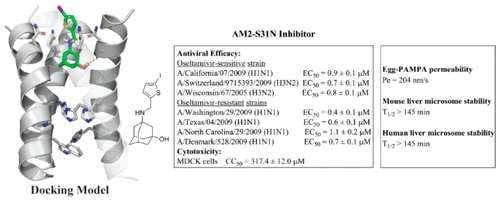Fighting mutant influenza

Another flu season is here, which means another chance for viruses to mutate. Already, most influenza A viruses contain a mutation that confers resistance against one class of antiviral medications, and the bugs are steadily gaining resistance against another class. Scientists report in ACS Medicinal Chemistry Letters a series of experiments designed to develop new medications that could potentially fight off the resistant and sensitive types of influenza A.
For most people, the flu is a nuisance, causing aches and pains, as well as coughs and runny noses for a few weeks. But for the elderly and young children, the illness can be deadly. And in the most recent flu season, even some seemingly healthy adults died after being infected. Because the virus can mutate, it has built up resistance against some drugs that had been used to help fight the infection. Influenza A is responsible for most cases of the flu, and about 95 percent of influenza A viruses have a mutation called S31N in the channel protein AM2. U.S. Food and Drug Administration (FDA)-approved antivirals called adamantanes target that protein, but are no longer recommended because the S31N mutation renders these drugs useless. The other FDA-approved class of antiviral medications includes oseltamivir. Although these drugs are still effective, resistance is growing with the rise of a mutation in a different viral protein. That's why Jun Wang and colleagues sought to develop a new medication that would work in both resistant strains and those that still respond to oseltamivir.
The key, Wang's team realized, was to target the AM2 protein with the S31N mutation, since it is found in almost all influenza A viruses. Using a step-wise process, the researchers identified one sulfur-containing inhibitor of AM2 S31N that was stable under conditions that mimic human metabolism. They then spun that discovery into a series of similar sulfur-bearing molecules, eventually identifying two compounds with even better antiviral properties than oseltamivir, fighting off drug-resistant and drug-sensitive strains. In addition, the researchers note that the two compounds have optimal in vitro pharmacokinetic properties, making them well-suited for the next step of in vivo studies in mice.
More information: Yanmei Hu et al, Structure–Property Relationship Studies of Influenza A Virus AM2-S31N Proton Channel Blockers, ACS Medicinal Chemistry Letters (2018). DOI: 10.1021/acsmedchemlett.8b00336

















